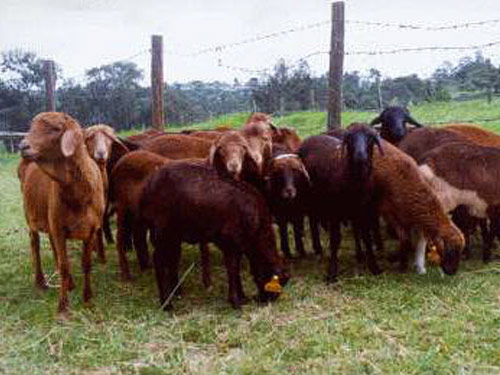

The Red Maasai sheep are also called Tanganyika sheep. They are sheep of the semi-arid regions of Kenya and Tanzania. Currently they are mostly found in the semi-arid regions of southern Kenyan and northern Tanzanian rangelands, especially in Kajiado District of Kenya and the neighboring districts. They are predominantly kept by the Maasai pastoralists as well as by the neighboring tribes.
Physical characteristics:
The Red Maasai sheep is identified by its relatively large body size and the population that have been studied most is, the one that was initially selected from Kajiado District in Kenya and breed for coat colour uniformity and improved conformation at the Naivasha-Kenya.
This strain is characterized by thick red hair. However, when all of the strains are considered, the sheep are multi-coloured, the most preferred colour by the Maasai and therefore the commonest being red, brown and occasionally pied.
Average height at withers is 73 (range = 72-75) cm for males and 62 (range = 58-66) cm for females.
Average heart girth and body length for females are 75.1 cm and 63.3 cm, respectively.
They are short, fat-tailed and slightly fat-rumped. In populations where a fat rump is a predominant feature indicate introgression of either Dorper or Black Head Somali/Persia sheep.
Peculiarity:
It resists worms and other diseases. On two indicators that together provide a reasonably reliable picture of resistance – faecal egg count and packed cell volume – Red Maasai ewes and lambs performed significantly better than Dorper sheep. The associated lowered mortality rates led to much faster flock growth and productivity. The number of one-year-old sheep available for sale in the Red Maasai flock was three times higher than in the Dorper flock.
The breed has also been shown to resist bluetongue virus infection and a more suited breed to survive under high trypanosome challenge.
Breed status
Despite its uniqueness in resisting endoparasites, there is no accurate population information among the pastoralists and mixed farmers who keep them. Red Maasai sheep population was estimated in 2002 at 235 400 for Uganda. No estimates are available for Kenya and Tanzania.
Utility
The Red Maasai are used for their meat and lard. Their reproductive performance in terms of lambing rate, is reported to be 80-84%, which is comparable to the Dorper sheep breed under medium rainfall zones in Kenya;
The lambing interval is about 340 days, which is long as compared to other East African sheep breeds, but can be improved to 246 days when crossed with the Dorper
The average litter size is about 1.13-1.21, which is lower than the Dorper and their crosses, greater than the Afar, Riverine Sudan and Black headed Persian breeds and similar to the Baggara of the Sudan.
 Contact Jaguza Support
Contact Jaguza Support